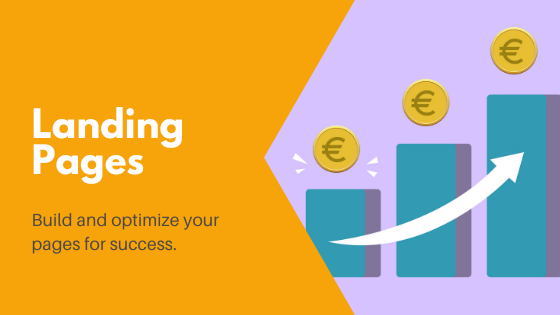These landing page best practices will help your small business build high-converting landing pages.

High-converting landing pages don’t just happen—they’re strategically put together
Landing pages aren’t something you quickly throw together.
There’s a lot of careful planning, strategy, and testing that goes into developing landing pages that convert.
You have to think about the big picture—your main objective as well as specific page goals—and focus on time-consuming details like:
- Page design
- Landing page copy
- The call to action
- Your hero image and visual elements
- Color choice
Then when they’re finally up and running, you have to monitor performance and continuously optimize landing pages for conversions.
In short, a lot of work goes into creating an effective landing page.
Ultimately, the resources put towards building and then driving visitors to the landing page can only be considered ‘well invested’ if the page converts. That is if people do what you intended for them to do on that page like submit a contact form, make a purchase, sign up your marketing emails or download gated content. Add to that, that, ideally, your landing pages should reduce the cost of acquiring new leads or landing a sale.
So how do you create successful landing pages? The landing page best practices outlined in this post are a great place for small businesses to start.
We’ll cover the following topics:
- What to include on a landing page
- How to build a successful landing page
- Landing page optimization: An overview
- Measuring results

What goes on a landing page? These are the key components of a good landing page.
A high-converting landing page is made up of several must-have elements.
These include:
- An engaging headline – you instantly want to capture interest.
- Effective copy – what you write should speak to your audience, keep visitors on the page, and guide readers to the call to action.
- Relevant keywords – these are words that people actually use to search for you and your products / services.
- Search intent – your landing page should anticipate and then address the person’s motivation as related to that specific search.
- Images – they should reflect the topic at hand, the prospect’s desire, and be of a professional quality.
- Call-to-action button – choose the right words (and colors) to convince the visitor to take action.
- Lead capture / conversion form – ask only for the information you need to perform or deliver the product / service.
Finally, depending on the campaign, you might also have social sharing buttons. As a rule of thumb though, landing pages should be distraction-free. In other words, giving visitors reason (and ways) to leave the page is counter-intuitive to the purpose of a landing page, which is to get the person to take action on that specific page.
That’s why navigation links should be left out whenever and wherever it is considered disruptive to the visitor’s purchase journey—where it stands in the way of conversion.
Ultimately, the resources put towards building and then driving visitors to the landing page can only be considered ‘well invested’ if the page converts.
Landing page best practices: How to create a landing page that converts!
Real talk: A landing page is only as good as its ability to convert.
That’s why effective landing pages are focused. They are targeted. And they are always goal-oriented.
Here are the landing page best practices every small business needs to pay attention to in order to create landing pages that convert.
Tip #1: No one sticks around on a messy, disorganized page
First impressions matter. And very often that first impression comes from the way a page looks; the visual appeal, feel and overall layout of the page.
Takeaway:
- Have sufficient white space;
- Choose eye-catching, relevant and high-quality images;
- Test color combinations, placement, and size for the optimal package.
Tip #2: Practice restraint
You’re the conductor and the various landing page components form your orchestra. Put another way, every landing page component has a role to play—they must work together to achieve harmony and it’s your job to get them to do that.
That’s why it’s important that you don’t go overboard with your page. That applies to visual components but also your copy. Incorporate what’s needed to seal the deal and leave all the other things out. Too much information can be overwhelming; too many elements can be distracting.
Takeaway:
- Keep your pages clean and well-structured;
- Edit without mercy (or hire a pro to do it for you);
- Your copy should be easy to read.
Tip #3: Give your headline lots of love
Most of the time, your headline is the first thing visitors are going to read on your landing page. If it doesn’t grab the visitor’s attention, spark interest, or scream value, the person may not bother reading much else on the page. In other words, the landing page headline is super important and therefore deserving of extra attention.
Takeaway:
- Have an irresistible offer;
- Include relevant keywords;
- Use a subheading where appropriate.
Tip #4: Message match is a must
Before visitors get to your landing page, they must first encounter a pay-per-click ad, click on a link in an email campaign, or see a post on social media. What you’ve written there builds expectations—expectations of what they’ll find when they click through.
For instance: If your ad focuses on wet puppy food for large breed dogs, then people expect you’re going to give them a page all about wet puppy food for large dogs – not a generic (overview) dog food page.
Takeaway:
- Be consistent;
- Match the words on your landing page with those in your ad (or even meta description);
- Link to the appropriate content.

Tip #5: It’s a mobile-users world
Whether it’s while we’re on the go or simply from the comfort of our beds, we all spend a significant amount of time every day on our mobile devices. As such, a large chunk of searches (around 50% of all web activity) happen on smartphones or tablets. That means, landing pages need to be mobile-friendly. No wonky layout allowed!
Takeaway:
- Test the mobile version of your landing pages before publishing;
- Pages should be easy to scroll and navigate;
- Must be quick to load.
Tip #6: Show readers you can be trusted
Where possible, add social proof to the landing page.
These trust signals can be in the form of:
- Testimonials
- Ratings
- Reviews
- Trust icons (“as seen on…”, “trusted by …”, “featured in” etc.)
- Statistics
- Endorsements
- Positive media coverage
- Stamps of approval / independent certifications (e.g. Bio-Siegel, Fair Trade, Oeko-Tex Standard 100, ISO certifications etc.)
Social proof lends your offer – and brand – credibility. In essence, it’s like having others vouch for you, which reduces perceived risk, and therefore increases the likelihood of someone taking action.
Takeaway:
- Add trust signals to your landing page;
- Use only real ratings, reviews, and testimonials;
- Familiarize yourself with all the proven ways you can build consumer trust.
Tip #7: Offer a solution
“Where can I order a low-sugar birthday cake for my mom?”
“How do I know how serious the leak in my roof is?”
“What kind of pillow should I buy to relieve neck pain?”
Whatever you do, at the end of the day you’re in the business of providing solutions, be it low-fat, low-sugar birthday cakes; free roof inspection and damage assessment; or adjustable buckwheat pillows.
Takeaway:
- Know your customers;
- Understand the problem at hand;
- Give actionable solutions.
Tip #8: Taking action should be quick and uncomplicated
Your landing page isn’t there for decoration—it exists to generate leads, to land you inquiries, or to secure a sale. Completing that action shouldn’t be overly complicated and shouldn’t require too much personal information. That’s where the attractiveness of your form and the quality of your call-to-action button come in.
Takeaway:
- Keep your forms short – the more fields you add, the less likely the form gets filled out;
- Only ask for the information you really need;
- Find the optimal button design (color, size, and placement) for conversion.
Tip #9: You can’t just set and forget
Consider your landing page as an ongoing work in progress; you’re going to want to continue fine-tuning to maximize conversions.
That is, you will make minor adjustments to your landing pages then observe which version performs better.
For instance: You want to get as many inquiries as possible for your low-fat, low-sugar specialty cakes, so you test out two different hero images to find out which one is more attractive to your audience.
Version A might have a photograph of various types of cakes to show that there’s a wide selection to choose from—low sugar doesn’t mean boring. Version B, on the other hand, might zoom in on just one cake (your best seller) with the focus on a mouth-watering slice, so people see just how delicious it looks.
Takeaway:
- Regularly check in on your landing pages;
- Tweak one landing page component at a time, bit by bit;
- Monitor performance.
Landing page optimization: An overview
Here’s a quick summary of how you can optimize landing pages for conversion:
- Remember that it’s about your customer, not you
- Be a minimalist – no clutter, no unnecessary information
- Eliminate distractions – you want to keep people on the page and move them to take action
- Simplify your forms, so that completing an action isn’t intimidating
- Craft copy that speaks to a specific audience – you can’t be everything to everyone
- Collect only the necessary information you need to nurture leads, fulfill a promise, deliver a product / service, etc.

Measuring results: Are your landing pages doing their job?
Once you’ve published your landing page, your next step is to monitor its performance and evaluate results. Did people do what you wanted them to do on the page?
The following metrics will help you gauge how well you’re doing and what you might need to work on.
- Bounce rate: The number of visitors to your landing page who leave without viewing any additional pages. You might also want to use your industry’s bounce rate as a benchmark.
- Click-through rate: The percentage of people who clicked on a link / button to bring them to the landing page.
- Traffic per device: The proportion of traffic according to devices visitors used to access the landing page.
- Conversion rate: The percentage of visitors that convert – take action – on your landing page.
- Cost per lead: Measures the cost of generating leads (i.e. the total cost of the campaign ÷ number of leads generated
With these landing page best practices in hand, you can now start building your own high-converting landing pages!